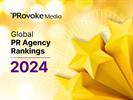Holmes Report 06 May 2019 // 12:53AM GMT

How is the corporate communication officer role changing? This is a complex, but critical question, given the impact of corporate reputation on organizational success across a range of sectors and industries.
While the need for sophisticated communication counsel has never been greater, the evolution of the corporate communications role is sometimes more difficult to fathom, given the pressures that have grown in tandem with this requirement. Corporate comms leaders may find their duties and budgets under threat from other C-suite execs (notably the CMO), while their departmental resources are further challenged and stretched — all while they are expected to adapt to a political, media and technological environment that has never appeared to change as quickly.
To better understand the future of the corporate communication officer role, the Holmes Report partnered with a new project led by the Wee Kim Wee School of Communication and Information at Singapore's Nanyang Technological University and supported by WE Communications. The findings make for fascinating reading, thanks to unique qualitative insight into the views of leading corporate comms professionals.
Methodology
In-depth interviews were conducted with 50 communication professionals between January 2019 to March 2019. The interviews were conducted by graduate students as part of the course, ‘Managerial Seminar in Corporate Communication’, at the Wee Kim Wee School of Communication and Information, Nanyang Technological University, Singapore. The research was done under the supervision of Ferdinand de Bakker and Amanda Huan.
The interviews covered two aspects: perceptions about the role and value of corporate communications professionals in companies, and perceptions about the specific issues and responsibilities of such professionals. Interviews were done either face-to-face or over the phone.
The research findings were then used as a basis for discussion at the industry roundtable.
The industry roundtable comprised the following participants:
• Jeremy Seow, CEO, Singapore, WE Communications
• Simon Pangrazio, Founding Partner, WATATAWA
• Arun Sudhaman, CEO & Editor-in-Chief, The Holmes Report
• Georgette Tan, President, Singapore Committee for UN Women
• Melissa Cheah, Communications Director, Southeast Asia, The Boeing Company
• Belina Tan, Head of Corporate Communications, Asia-Pacific, Bloomberg LP
• Andrew Pickup, Senior Director, Communications, Microsoft Asia
• Ferdinand de Bakker, Lecturer, Wee Kim Wee School of Communication and Information, Nanyang Technological University
Research Findings
The Evolving Role of the Corporate Communication Professional
Most practitioners agree that the role of the corporate communication (corp comm) professional has largely remained constant over the last few decades. What has changed, however, is the environment in which such professionals operate in.
The world has changed rapidly. First, there have been significant changes in the media landscape; where traditional print media was once king, social and digital platforms are fast becoming consumers’ top choice for media and information consumption. This has been facilitated by the rapid advancement of technology. Whereas top-down communication pushed out by corporates meant that they were in control of pace and content, today’s 24/7 news-cycle and the decentralisation of content creation means that corporate communication professionals are forced to monitor news constantly and to respond quickly to any potential crisis, no matter big or small. The changes in the operating environment have added layers of complexity to the corporate communication role.
The impact from these environmental changes have not been entirely negative. As communication becomes more complex, the value of communicators has increased. Organisations are recognising the value that corporate communication professionals bring and the influence that these professionals wield has amplified. The role of chief communicators has been elevated and many often play the role of the CEO’s information custodian, keeping the CEO updated of relevant developments and helping the CEO to understand communication issues.
Corporate communication professionals now play an important role as the organisation’s chief corporate brand guardian. While this may have primarily entailed media relations in the past, in today’s world, the scope of work has expanded to a multi-stakeholder approach towards narrative building and reputation management. There has also been a paradigm shift in mindset from a tactically-focused one to a more strategic level of thinking. Corporate communication professionals are now expected to be knowledgeable about the different aspects of the business beyond the communication function as well.
Many practitioners predict that there will be further change. It will continue to be challenging as reputation becomes exceedingly important due to the increasing lack of trust in public institutions. People will continue to demand more from brands and will want to better understand brands that they buy from. An added layer of complexity is regulation. The rise of the digital economy and the loss of faith and trust in organisations will necessitate a shift towards greater regulation. Corporate communication professionals will have to deal with new constraints in an already-challenging environment.
Measuring the Success of Corporate Communications
The days of measuring column inches and AVEs are long past. With the advent of big data and data-driven communication, there has been a turn towards digital metrics and measures of online engagements. While these measures offer a somewhat greater sophistication in terms of indicators of corporate communication effectiveness, they remain far from perfect. In fact, the rush for big data and other metrics has led to an obsession with numbers with no real appreciation for what exactly one is measuring.
Most practitioners talked about the ultimate end goal – impact on sales – but there remains a struggle in linking communication initiatives directly to revenue figures. A vast majority of practitioners also talked about the other ultimate end goal – impact on brand perception – but it remains unclear how one might measure it effectively.
There remains an industry need to develop more accurate and useful assessors for the effectiveness of corporate communication. While the development of the Barcelona Principles have helped shift mindsets away from AVEs and other output-oriented measures, the industry still falls short in being able to measure its own effectiveness.
The Blurring of Marketing and Corporate Communication
Practitioners largely agreed that the role of marketing and corporate communication has blurred. While some viewed this optimistically and felt that the two should be integrated, others were more wary of the lack of clarity between the two functions. Most agreed that the two should minimally have a collaborative relationship where neither function is superior to the other. In today’s world where a company’s brand is key to its survival, it is necessary that the two functions are in sync. Most practitioners felt that the importance of both functions was of such a high degree that both should report directly to the CEO.
Responsibilities of the Corporate Communication Team
Across the different types of issues and responsibilities, namely, employee engagement, investor relations, CSR, crisis preparedness and communication planning, social media engagement, public affairs and government relations, and corporate advertising, most practitioners felt that the corporate communication team should be involved in varying capacities across all of them.
This harkens back to the notion that in today’s age, an organisation’s brand lies at its heart and all other functions flow from it. Not involving someone who is familiar with the brand narrative in any of these core functions risks brand misrepresentation stemming from incoherent or inconsistent messaging. This applies to both internal and external stakeholders.
While some functions (i.e. investor relations and employee engagement) will require the expertise of other professionals (i.e. financial analysts and HR professionals), most practitioners felt that a communication person or at least a communication-trained person must sit in all of these functions. This goes back to the earlier idea of how today’s corporate communication professionals should be knowledgeable about and comfortable with dealing with the entire business across functions and business units.
Roundtable Discussion
Communication in a Disrupted World
Communication professionals are now living in a real-time, issues-rich environment due to the proliferation of technology and digital platforms. The speed of change in the media ecosystem, coupled with toxic content and fake news, requires corporate communication officers to be adept at thinking quickly on their feet and reacting with equivalent alacrity. The interconnectedness of issues also calls for greater social and cultural awareness and sensitivity. Where media engagement was once the bread-and-butter for the corporate communication professional, panelists remarked that media relations comprises a mere one-fifth of the work now.
The panelists also agreed that there are now greater demands for companies to be ‘authentic’. In contrast to yesteryears, consumers today are buying brands and not products. In order for companies to engender trust, businesses need to start thinking about what they are going to stand for and what their mission is. The job of the communicator is to communicate these key messages consistently and companies must live up to the values that they set for themselves or risk alienating consumers. Therein highlights the key tasks of communicators in today’s world – building and protecting the brand and building relationships with stakeholders.
The Synergy between Marketing and Communications
Marketers and communicators often, unfortunately, have an antagonistic relationship; this stems from perceptions over one being a profit center and the other a cost center. Technology and ever-blurring lines between paid, earned, and owned media have since spurred a convergence of both sides. While tension remains between marketers and communicators, today’s business environment calls for a more synergistic relationship between the two.
The panel highlighted the importance for both departments to work together in order to successfully communicate company narratives and drive both short- and long-term revenues. What has further complicated the divide between the two disciplines is the blurring of responsibilities and platforms – when does social media become marketing tool and when does it become a communication tool?
Chief Marketing Officers are also increasingly taking on responsibilities that would more naturally appear in a communication officer’s job scope. One panelist made a mention of the backlash surrounding the Kendall Jenner PepsiCo ad campaign as a clear example of a marketeer trying to weave a narrative around a social issue without the proper communication or public relations expertise.
How can one reconcile the divide? A deeper understanding and appreciation of both functions will reduce both the need to compete and the need to prove that one is superior to the other. The marketing department often has, at its disposal, valuable tools that can measure key information such as sales data and promotion take-up rates – data that would be useful for the communications department to leverage on.
The panel offered another perspective of the relationship between the two, noting that while marketing is primarily concerned with revenue, communication exists as a lubricant to facilitate sales; one cannot do without the other. One suggested. recourse is to take a step back and address the fundamental questions: “What is the problem we are trying to solve? What is the opportunity we are trying to seize?”. With this approach, both departments can focus on the true issue at hand and use the relevant means to address it.
Skillsets of the Future Corporate Communication Officer
For the new generation adjusting to the disrupted landscape, the panel pointed to core skillsets that communicators must equip themselves with. First, they must read widely and keep themselves abreast of worldly issues and current affairs. Understanding how an issue may impact a business across multiple fronts is a necessity in today’s world.
Related to this skill is the need for communicators to write well. Communication officers must be able to deconstruct complex and technical issues into messages that are simple, clear, and compelling. Second, communicators must possess a degree of nimbleness and cultural sensitivity in order to better navigate cross-cultural situations.
Third, communicators need to be adept at multiple aspects of the business and must lose any fear of numbers and data. In today’s big data world, an appreciation for spreadsheets and analytics is key to maintaining an edge over the competition. Consumer insights gleaned from data is necessary to calibrate communication messages, create more targeted messaging, and refine audience segmentation.
The use of data in communication needs to be combined with a deep understanding of business needs and societal trends. One panelist posted the following: how is it that companies can still get things wrong so often in a world awash with data and analytics? In response, other panelists commented that a major reason for why the communication department is so important is because of the need for corporate communication officers to blend data with good judgment, strategy, and common sense and avoid a blind adherence to data.
Importance of Employee Engagement
Panelists stressed the increasing importance of employee communications, and how the role of employees has evolved from just working for a company to becoming an advocate for the company’s brand. They foresee increased investment in employee communication and engagement and predict that there will be a shift from employee engagement to employee activism where employees are empowered and can truly connect with a company’s purpose. One such example is Google’s decision to abandon a military program that uses artificial intelligence to analyse drone footage after employees objected strongly to the program.
Employees are actively seeking ways in which they can have more influence on company decisions. With the proliferation of social media platforms, it is easier to ‘talk up’ to the C-suite executives. This has effectively eliminated the age-old model of one-way employee communication and paved the way for more open conversations that can drive positive change, create more conducive working environments, and increase employee satisfaction.



































.jpg)






























